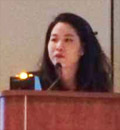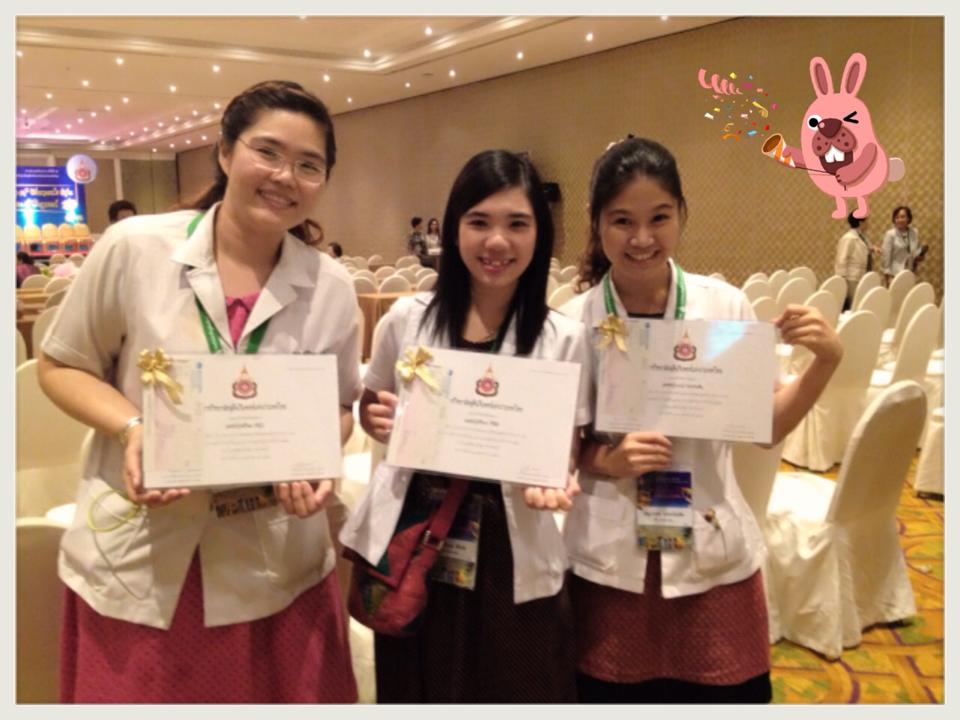งานวันวิจัย ประจำปี 2557 มีการนำเสนอผลงานวิจัยของแพทย์ประจำบ้านปีที่ 3 (นำเสนอเป็นภาษาอังกฤษ เป็นการเตรียมพร้อมในการนำเสนอต่อราชวิทยาลัยสูติ-นรีแพทย์) ครั้งที่ 6 วันที่ 29 กันยายน 2557 ณ ห้องประชุม ม.จ.อำนอร์สวัสดิ์-ศุภร มีการประกวดนำเสนอผลงานวิจัย (ดูภาพบรรยากาศในงานวันวิจัยได้ใน menu: Gallery ซึ่ง ผลงานวิจัยและรายนามผู้ได้รับรางวัลมีดังนี้
- รางวัลที่ 1 พญ.บงกช ชาครบัณฑิต: Comparison between Preterm Delivery Rates of HIV-infected Pregnant Women Receiving Highly Active Antiretroviral Therapy (HAART) Containing Protease Inhibitors (PIs) and HIV-infected Pregnant Women Receiving Zidovudine Monotherapy
- รางวัลที่ 2 น.พ. เจษฎา ใจพรหม: Pregnancy outcomes among mothers at age of 15 years or less
- รางวัลที่ 3 พ.ญ. ศศิวิมล ศรีสุโข: Adherence to Guidelines on the Diagnosis of Cephalo-pelvic Disproportion at Maharaj Nakorn Chiang Mai hospital
ผลงานวิจัยที่นำเสนอมีดังนี้
Pregnancy outcomes among chronic carriers of hepatitis B virus
Sirinart Sirilert, MD; Kuntharee Traisrisilp, MD; Pannee Sirivatanapa, MD; Theera Tongsong , MD
Department of Obstetrics and Gynecology, Faculty of Medicine, Chiang Mai University, Chiang Mai, Thailand
Abstract
Objective: To compare pregnancy outcomes of women with chronic HBV infection with those of HBV-negative women.
Methods: A retrospective cohort studywas undertaken to analyze singleton pregnancies of women without medical/surgical disease and with known HBsAg status. Pregnancy outcome measures were compared among the control group, women with positive HBsAg status (case group), and those with positive HBeAg status.
Results: Among 26 350 enrolled pregnant women, 21 812 in the control group and 1446 in the case group were compared. Only the proportion of preterm births was significantly higher among pregnancies with positive HBsAg status (RR 1.013 [95% CI, 1.001–1.025]). Among women with positive HBsAg status who had been screened for HBeAg, GDM was significantly higher among women with positive HBeAg status (RR 1.434 [95% CI, 0.999–2.057]). Preterm births and low birth weight were also significantly higher among women with positive HBeAg status (RR 1.250 [95% CI, 1.000–1.563] and 1.258 [95% CI, 1.053–1.505], respectively).
Conclusion: Chronic carriers of HBV had a minimally increased risk of preterm birth and low birth weight but the risk was more pronounced in women with positive HBeAg status. Women with positive HBeAg status also had an increased risk of GDM.
Outcomes of pregnancy with gestational diabetes mellitus at Maharaj Nakorn Chiang Mai hospital; 10-year experience
Supansa Srichumchit MD; Suchaya Luewan MD; Theera Tongsong MD;
Abstract
Objective : To determine pregnancy outcomes of women complicated by gestational diabetes mellitus
Method : Pregnant women complicated with gestational diabetes mellitus(GDM) between January 2002 and December 2012, at Maharaj Nakorn Chiang Mai Hospital, were recruited to a retrospective study. The normal controls were low risk cases delivered in the same period. The primary outcome was fetal macrosomia and secondary outcomes included maternal and fetal mortality and morbidity such as cesarean section rates, shoulder dystocia and stillbirth.
Result : A total of 1350 pregnancies with GDM and 20421 controls were recruited. The baseline characteristics regarding age, maternal weight, number of visits and parity was significantly higher in GDM group. The main outcome, fetal macrosomia was higher in GDM group with 20% vs 13.6% (adjusted OR=1.478, 95%CI 1.281-1.705, P < 0.001). The incidence of cesarean section, cephalopelvic disproportion, pregnancy induced hypertension and shoulder dystocia increased significantly in GDM group (adjusted OR = 1.360, 95%CI 1.203-1.537, 1.562, 95%CI 1.909-1.864, 1.668, 95%CI 1.389-2.004 and 7.844, 95%CI 3.291-18.700, respectively) whereas stillbirth rate was similar between GDM and control group.(1.4% vs 1.5%)
Conclusion: Gestational diabetes mellitus associated adverse pregnancy outcomes such as fetal macrosomia, increased cesarean section rate, cephalopelvic disproportion, shoulder dystocia and pregnancy induced hypertension.
Key words: gestational diabetes mellitus, pregnancy outcome, macrosomia
The prevalence of conditions causing chronic anovulation and the proposed algorithm for anovulation evaluation in a hospital with low-resources
Pitch Chandeying MD, Tawiwan Pantasri MD
Abstract
Purpose: The aim of this study was to investigate the prevalence of disease-causing chronic anovulation and propose an investigation flow chart for women presenting with chronic anovulation in places with limited resources.
Methods: The cross-sectional retrospective study was performed among 293 reproductive age women who were diagnosed with chronic anovulation at the Gynecologic Endocrinology Unit, Faculty of Medicine, Chiang Mai University between January 2008 and December 2012. The demographic data, laboratory investigations and diagnoses were collected.
Results: Among 293 patients recruited into the study, the common causes of anovulation were polycystic ovarian syndrome (PCOS) (73.5%), prolactin disorder (13.3%) and unexplained chronic anovulation (7.5%). The less common causes were thyroid disorders, congenital adrenal hyperplasia (CAH), adrenal tumors and Cushing’s disease. There was a strong positive association between the levels of 17-hydroxyprogesterone and/or dehydroepiandrosterone sulfate with the levels of testosterone and androstenedione. The sensitivity and specificity of serum LH to accurately diagnose PCOS were 29.38% and 55.56% (P = 0.03). The LH/FSH ratio ≥ 3 had a sensitivity and specificity at 18.56% and 92.86% (P =0.03) for PCOS diagnosis.
Conclusion: Serum androstenedione, testosterone, thyroid stimulating hormone, and prolactin levels and pelvic ultrasonography should be included in the initial investigations for anovulation. The 17-hydroxyprogesterone and dehydroepiandrosterone sulfate levels can be used for secondary anovulation evaluations.
Keywords: Amenorrhea, Oligomenorrhea, Anovulation cause, Anovulation evaluation
Comparison between Preterm Delivery Rates of HIV-infected Pregnant Women Receiving Highly Active Antiretroviral Therapy (HAART) Containing Protease Inhibitors (PIs) and HIV-infected Pregnant Women Receiving Zidovudine Monotherapy
Bongkot Chakornbandit MD; Fuanglada Tongprasert MD
Abstract
Objective: To compare the preterm delivery rates between pregnant women receiving HAART containing protease inhibitors (HAART-PIs) and zidovudine monotherapy (ZDVm) during pregnancy.
Materials and Methods: A retrospective cohort study was conducted in naïve HIV-infected pregnant women who received at least 4 weeks of antiretroviral drugs between January 2002 and December 2013 in Maharaj Nakorn Chiang Mai Hospital, Chiang Mai, Thailand. Preterm delivery rates were compared between HAART-PIs and ZDVm groups.
Results: Of the 166 pregnant women who received antiretroviral drugs, 24 (14.5%) pregnant women delivered before 37 completed weeks. The incidence of preterm delivery was higher in the HAART-PIs group (82 cases) than in the ZDVm group (84 cases), but the difference was not significant (18.3% vs. 10.7%, p = 0.17). In the multivariate analysis, only CD4+ < 200 cells/mm3 before delivery was associated with preterm delivery (OR 44.0, 95% CI 1.5–1328.5, p = 0.04).
Conclusion: An almost twofold incidence of preterm delivery rate was observed in those pregnant women who received HAART-PIs, a rate which is higher than that of the general population; however, the rate was not significantly different from the rate of those who received ZDVm. These pregnant women should be counseled regarding the risks of preterm birth in order that they gain access to close monitoring, early detection, and proper management.
Keywords: HIV, HAART, zidovudine, preterm delivery, protease inhibitors
Adherence to Guidelines on the Diagnosis of Cephalo-pelvic Disproportion at Maharaj Nakorn Chiang Mai hospital
Sasivimol Srisukho MD; Theera Tongsong MD; Kasemsri Srisupundit MD
Abstract
Objective: To determine the degree of adherence to guidelines on the diagnosis of cephalopelvic disproportion (CPD) in Maharaj Nakorn Chiang Mai hospital.
Methods: The database of pregnant women who underwent cesarean delivery due to CPD from 2010 to 2012 was reviewed. The degree of adherence to guidelines on the CPD diagnosis was recorded which using guidelines from Royal Thai College of Obstetricians and Gynecologists (RTCOG) and the American Congress of Obstetricians and Gynecologists (ACOG) as gold standard criteria for CPD diagnosis.
Results: Forty hundred and sixty four pregnant women who were diagnosed as CPD were recruited. The adherence to guidelines either RTCOG or ACOG criteria was 80.4%. Of 91 cases that had incomplete criteria to diagnose CPD, 25 cases (27.5 %) had been suspected of fetal macrosomia and CPD was diagnosed during latent phase of labor. Unfortunately, 76% of these fetuses had birth weight less than 4000 grams which were unlikely to be macrosomia.
Conclusion: The adherence to guidelines on the diagnosis of CPD was 80.4%. Almost one-third of these cases were false diagnosis of fetal macrosomia. Therefore, the strategy of accurately fetal weigh estimation may reduce unnecessary cesarean section from false diagnosis of CPD.
Recurrence patterns and associated factors of endometrial cancer in northern Thai women
Kaewpangchan P, Cheewakriangkrai C
Abstract
Objective. The aim of this study was to analyze endometrial cancer (EC) patients to better define clinicopathologic associations, patterns of recurrence, and survival
Methods. Medical records were abstracted from EC patients who underwent a primary surgery from 1999 to 2012. Data on clinicopathologic variables, sites of first recurrence, time to relapse of disease, and overall survival were analyzed and associations between variables were determined.
Results. Among 1204 reviewed patients, 42 patients were identified with recurrent disease. The median age was 55 years. The median follow-up time was 26.0 months. The majority of initial relapses were distant (29/42, 69%). The only predictor of pelvic lymph node involvement on univariate analysis was patient’s age. The lymphovascular space involvement and deep myometrial invasion were present in 66.7% and 57.1%, respectively. The median time from surgery to recurrence was 8.6 months. Patients with endometrioid histology had a significant longer disease-free interval compared with non-endometrioid histology (14.6 vs. 8.8 months, P=0.006). The 3-year survival rate was 41.1%.
Conclusions. Both local and distant recurrences yielded a worse prognosis in EC patients although a distant relapse was quite common. A closed follow-up should be performed during the first year after completion of treatment especially in patients with non-endometrioid histology.
Prevalence and predicting factors for anxiety disorder in women with abnormal cervical cytology undergoing colposcopy
Tanut Jerachotechueantaveechai, MD, Kittipat Charoenkwan, MD, Nahathai Wongpakaran, MD
Abstract
Objective: To compare prevalence of anxiety disorder in women with abnormal cervical cytology undergoing colposcopy to that of women attending the outpatient clinic for check-up and to examine predicting factors for anxiety disorder in the women with abnormal cervical cytology.
Methods: In this cross-sectional analytical study, 100 women with abnormal cervical cytology (study group) and 100 women who attended our outpatient clinic for check-up (control group) were recruited from June 2013 to April 2014. We used the questionnaire, Hospital Anxiety and Depression Scale (HADS) to determine anxiety level of the participants with the score of > 8 suggestive for anxiety disorder. The prevalence of anxiety disorder and the median HADS scores for anxiety were compared between the groups using chi-squared test and Mann-Whitney U test, respectively. For those with abnormal cervical cytology, association of clinical factors with anxiety disorder was assessed. The p-value of < 0.05 was considered significant.
Results: Median age was different between the groups, 44.0 years old in the study group and 50.0 years old in the control group (P=0.01). Proportion of participants who had more than one sexual partner was higher in the study group, 39.2% vs. 24.7% (P=0.05). The prevalence of anxiety disorder was significantly higher in the study group, 34.0% vs. 18.0% (odds ratio 2.35, 95% confidence interval 1.22-4.53, P=0.01). The median HADS scores for anxiety was significantly higher in the study group, 6.0 vs. 4.0 (P=0.01). For the study group, no definite association between clinical factors and anxiety disorder was demonstrated.
Conclusions: The prevalence of anxiety disorder in women with abnormal cervical cytology awaiting colposcopy were significantly higher than that of normal controls. Special attention including thorough counselling and psychological support should be directed to these women. However, predicting factors for anxiety disorder in this group of women were not discovered.
Keywords: abnormal cervical cytology, anxiety, HADS, hospital anxiety and depression scale, pap smear
Pregnancy outcomes among mothers at age of 15 years or less
Jedsada Jaiprom, M.D.; Kuntharee Traisrisilp, M.D.; Suchaya Luewan, M.D.; Theera Tongsong, M.D.
Abstract
Objective: To determine pregnancy outcomes among early adolescent women (age≤15years) compared with those at age of 20-30 years
Patients and Methods: A retrospective cohort study was undertaken using the obstetric database of Thai population. All consecutive records of singleton pregnancies with maternal age ≤15years and those at age of 20-30 years were recruited as the study and control group, respectively. The primary outcomes for comparison were the rates of preterm birth, low-birth weight, growth restriction and cesarean section.
Results: A total of 29,321 pregnancies were enrolled, including 298 adolescent pregnancies and 29,023 controls. Most baseline characteristics were not significantly different but rates of pregnancy complicated by medical diseases were significantly higher in the control group, in particular diabetes mellitus (1.3% vs 6.0%) and chronic hypertension (0.7% vs 1.1%), but the rate of iron deficiency anemia was significantly higher in the study group (5.4% vs 1.3%). The study group had significantly higher rates of preterm birth (31.9% vs 14.5%), growth restriction (11.7% vs 7.1%), low-birth weight (28.9% vs 14.7%), while maternal morbidity such as preeclampsia or placenta previa etc was comparable. Of interest, the primary cesarean rate was significantly lower in early adolescent women (6.7% vs 12.3%).
Conclusion: Early adolescent pregnancy was associated with higher risks of adverse pregnancy outcomes, in particular preterm birth and growth restriction, though most maternal morbidity was comparable with that in the control group. Cesarean rate was significantly lower in early adolescent mothers. This information should be informed to the women and their family.
Prevalence and predicting factors for anxiety disorder in ovarian cancer patients following treatment
Saranya Chittrakul, MD, Kittipat Charoenkwan, MD, Nahathai Wongpakaran, MD
Abstract
Objective: To compare prevalence of anxiety disorder in women with ovarian cancer following primary treatment to that of women attending the outpatient clinic for check-up and to examine predicting factors for anxiety disorder in the women with ovarian cancer.
Methods: In this cross-sectional analytical study, 56 ovarian cancer patients who had primary surgical treatment within last five years at our hospital (cancer group) and 56 age-matched women who attended our outpatient clinic for check-up (non-cancer group) were recruited from June 2013 to January 2014. The questionnaire, Hospital Anxiety and Depression Scale (HADS), was used to determine anxiety level of the participants with the score of > 8 suggestive for anxiety disorder. The prevalence of anxiety disorder and the median HADS scores for anxiety were compared between the study groups employing chi-squared test and Mann-Whitney U test, respectively. For those with ovarian cancer, association of clinical and pathological factors with anxiety disorder was examined. The p-value of < 0.05 was considered significant.
Results: Median age was comparable between the study groups, 51.5 years old in the cancer group and 54.5 years old in the non-cancer group (P=0.71). Proportions of participant who had any underlying medical conditions (53.6% vs. 25.0%), salary > 10,000 baht/month (69.6% vs. 42.9%), and university education (69.6% vs. 48.6%), were significantly higher in the non-cancer group. The prevalence of anxiety disorder was similar between the groups, 21.4% in the cancer group and 30.4% in the non-cancer group (odds ratio 0.63, 95% confidence interval 0.27-1.47, P=0.28). The median HADS scores for anxiety was significantly higher in the non-cancer group, 6.4 vs. 4.0 (P=0.01). For the cancer group, no association between any particular clinical and pathological factors and anxiety disorder was demonstrated.
Conclusions: The prevalence of anxiety disorder in women with ovarian cancer following primary treatment were comparable to that of women attending the outpatient clinic for check-up. The predicting factors for anxiety disorder in this group of patients were not identified.
Keywords: anxiety, HADS, hospital anxiety and depression scale, ovarian cancer



















